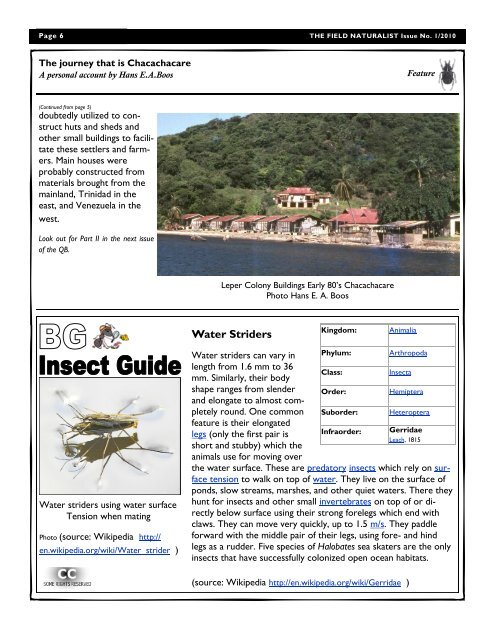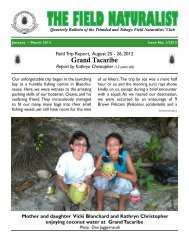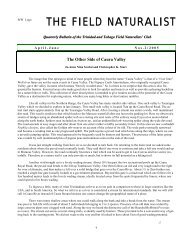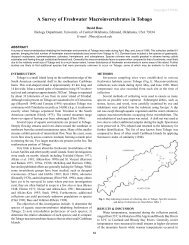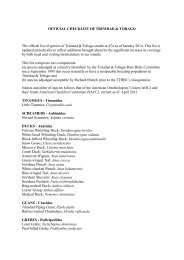Page 6 THE FIELD NATURALIST Issue No. 1/2010<strong>The</strong> journey that is ChacachacareA personal account by Hans E.A.BoosFeature(Continued from page 5)doubtedly utilized to constructhuts <strong>and</strong> sheds <strong>and</strong>other small buildings to facilitatethese settlers <strong>and</strong> farmers.Main houses wereprobably constructed frommaterials brought from themainl<strong>and</strong>, <strong>Trinidad</strong> in theeast, <strong>and</strong> Venezuela in thewest.Look out for Part II in the next issueof the QB.Leper Colony Buildings Early 80‘s ChacachacarePhoto Hans E. A. BoosWater StridersKingdom:AnimaliaWater striders using water surfaceTension when matingPhoto (source: Wikipedia http://en.wikipedia.org/wiki/Water_strider )Water striders can vary inlength from 1.6 mm to 36mm. Similarly, their bodyshape ranges from slender<strong>and</strong> elongate to almost completelyround. One commonfeature is their elongatedlegs (only the first pair isshort <strong>and</strong> stubby) which theanimals use for moving overPhylum:Class:Order:Suborder:Infraorder:ArthropodaInsectaHemipteraHeteropteraGerridaeLeach, 1815the water surface. <strong>The</strong>se are predatory insects which rely on surfacetension to walk on top of water. <strong>The</strong>y live on the surface ofponds, slow streams, marshes, <strong>and</strong> other quiet waters. <strong>The</strong>re theyhunt for insects <strong>and</strong> other small invertebrates on top of or directlybelow surface using their strong forelegs which end withclaws. <strong>The</strong>y can move very quickly, up to 1.5 m/s. <strong>The</strong>y paddleforward with the middle pair of their legs, using fore- <strong>and</strong> hindlegs as a rudder. Five species of Halobates sea skaters are the onlyinsects that have successfully colonized open ocean habitats.(source: Wikipedia http://en.wikipedia.org/wiki/Gerridae )
Page 7 THE FIELD NATURALIST Issue No. 1/2010La Table 31 st January 2010Reginald Potter, with input from Eddison BaptisteMonthly <strong>Field</strong> Trip ReportsLa Table (usually pronounced ―La Tab‖) is a small bayon the south coast just east of Las Tablas point, reachableby boat, or by a long hike through the VictoriaMayaro forest reserve starting from the ―Main <strong>Field</strong>‖road through Guayaguayare at a point a little west ofLagon Bouffe. An extension of the Trinity Hills forms asteep ridge trending NE – SW runs all the way to thecoast at Moruga, <strong>and</strong> this natural barrier separates theLa Table River, which flows east to the coast, from thel<strong>and</strong> to the north which all drains to the west into theMoruga River.We were to discover justhow long that hike might be<strong>and</strong> something about thatridge when we convergedon Guayaguayare on Sunday31 st January .24 persons made the trip toGuyaguayare <strong>and</strong> after collectingour guide IgnaciousPhillip Cummings we met atthe Petrotrin gate at about9.00 am. We had met Phillipbefore when he guided us toCanari bay.In the car I received the firstbit of bad news – Phillip hadnot been to ―La Tab‖ for 20years or more! And that tripwas largely in the night whenhe was called there on newsthat his brother <strong>and</strong> 4 otherswere drowned while bathing.Nevertheless he was confident that he could find theplace <strong>and</strong> being a well-known ‗bushman‘ we had littlechoice but to trust him. We were at the starting pointat 10.05 am, crossed the NGC gas pipeline wayleave,entered the forest, <strong>and</strong> proceeded briskly down an oldexploration well access road that runs due south, makinggood progress initially. Traces of imported limestone<strong>and</strong> old washed out culverts provided proof thatthis was indeed a road, but vegetation including largecedars had grown up in the roadway since its last use.<strong>The</strong>re were clear signs of timber poaching by illegalloggers who had used a portable sawmill to plank thosebeautiful cedars. Evidently they must have been interruptedbecause some logs were left ab<strong>and</strong>oned <strong>and</strong> stillDan Jaggernauthinvestigating signs of illegal logginground.We trecked through Semi Evergreen Forest seeing awild chatigne tree with fruit (edible), a massive SilkCotton tree that echoed of forgotten folklores,(traditions, <strong>and</strong> superstitions that brought reflectivesmiles <strong>and</strong> murmurs). We saw a Carapa guianensistree, (Crappo fruit) which is used as an herb forcoughs <strong>and</strong> colds <strong>and</strong> lumber for building. <strong>The</strong>re werecarat palms, wild nutmeg with it‘s buttress roots which,unlike our shoes, made it stable in soggy soils. All thisinfo: was courtesy Dan.We saw (or rather heard)two birds:- one was theWhite Bearded Manikin <strong>and</strong>the other the Yellow TailCrested Oropendola. ClaytonHull also heard a toucanseveral times <strong>and</strong> the unmistakablesound of a woodpecker.As usual no wildlifewas seen, partially due tothe constant chatter of ourlarge party.After several detours tocross streams (all flowingwest <strong>and</strong> practically devoidof fish life) <strong>and</strong> rejoining theroad, we started slightly uphill<strong>and</strong> came to what appearedinitially to be a hunters‘camp. This was a bit of asurprise since the area is agame sanctuary. In fact the presence of a well worntrail in a sanctuary was enough to arouse suspicion.<strong>The</strong> camp appeared well <strong>and</strong> recently used, with beds<strong>and</strong> clothing <strong>and</strong> even torches <strong>and</strong> cooking equipmentin evidence.From this point our troubles began. Phillip chose a wellmarked trail which quickly began to look unlikely sinceit took us across gullies that were otherwise easilyavoidable. He turned back <strong>and</strong> tried another trail onlyto return again claiming it quickly lead to a steep inclinethat would present difficulty to some members.However those who managed to keep up with himreported seeing a marijuana field.Back down the slope <strong>and</strong> branching this time more to(Continued on page 8)


